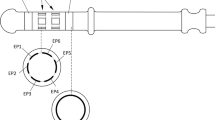Abstract
PURPOSE: This study was undertaken to evaluate how well anorectal manometry and transanal ultrasonography diagnose anal sphincter injury. METHODS: Anorectal manometry and transanal ultrasonography were performed in 20 asymptomatic nulliparous women and 20 asymptomatic parous women, and the results were compared with those obtained in 31 incontinent women who subsequently underwent sphincteroplasty and, thus, had operatively verified anal sphincter injury. By using computerized manometry analysis, mean maximum resting and squeeze pressures, sphincter length, and vector symmetry were determined in all women. All transanal ultrasounds were interpreted blinded as to the patient's history, physical examination, and manometry results. RESULTS: Manometric resting and squeeze pressures were significantly higher in the asymptomatic nulliparous women than in the asymptomatic parous women, and both groups had significantly higher pressures than the incontinent women ( P <0.001). Anal sphincter length and vector symmetry index were significantly decreased in incontinent women compared with asymptomatic women ( P <0.01). Decreased resting and squeeze pressures suggestive of possible sphincter injury were found in 90 percent of incontinent women with known anal sphincter injury. Decreased anal sphincter length and vector symmetry were found in only 42 percent of women with known anal sphincter injury. Transanal ultrasound was able to identify 100 percent of the known sphincter injuries but also falsely diagnosed injury in 10 percent of the asymptomatic nulliparous women with intact anal sphincters. False identification of sphincter injury increased when transanal ultrasound scanning was performed proximal to the distal 1.5 cm of the anal canal. CONCLUSION: Although nonspecific, decreased resting and squeeze pressures were found in 90 percent of patients with anal sphincter injury. Decreased anal sphincter length or vector symmetry index were present in only 42 percent of patients with known sphincter injury. When limited to the distal 1.5 cm of the anal canal, transanal ultrasound identified all known sphincter injuries but falsely identified injury in 10 percent of women with intact anal sphincters. Transanal ultrasound in combination with decreased anal pressures correctly identified all intact sphincters and 90 percent of known anal sphincter injuries.
Similar content being viewed by others
References
Keighley MR, Fielding JW. Management of faecal incontinence and results of surgical treatment. Br J Surg 1983;70:463–8.
Snooks SS. Effects of childbirth. In: Kuijpers HC, ed. Colorectal physiology: fecal incontinence. Boca Raton: CRC Press, 1994:41–6.
Law PJ, Kamm MA, Bartram CI. A comparison between electromyography and anal endosonography in mapping external anal sphincter defects. Dis Colon Rectum 1990;33:370–3.
Burnett SJ, Speakman CT, Kamm MA, Bartram CI. Confirmation of endosonographic detection of external anal sphincter defects by simultaneous electromyographic mapping. Br J Surg 1991;78:448–50.
Tjandra JJ, Milsom JW, Schroeder T, Fazio VW. Endoluminal ultrasound is preferable to electromyography in mapping anal sphincter defects. Dis Colon Rectum 1993;36:689–92.
Perry RE, Blatchford GJ, Christensen MA, Thorson AG, Attwood SE. Manometric diagnosis of anal sphincter injuries. Am J Surg 1990;159:112–7.
Law PJ, Bartram CI. Anal endosonography: technique in normal anatomy. Gastrointest Radiol 1989;14:349–53.
Sultan AH, Nicholls RJ, Kamm MA, Hudson CN, Beynon J, Bartram CI. Anal endosonography and correlation within vitro andin vivo anatomy. Br J Surg 1993;80:508–11.
Deen KI, Kumar D, Williams JG, Olliff J, Keighley MR. Anal sphincter defects: correlation between endoanal ultrasound and surgery. Ann Surg 1993;218:201–5.
Falk PM, Blatchford GJ, Cali RL, Christensen MA, Thorson AG. Transanal ultrasound and manometry in the evaluation of fecal incontinence. Dis Colon Rectum 1994;37:468–72.
Fleshman JW. Determination of pudendal nerve terminal motor latency. In: Smith LE, ed. Practical guide to anorectal testing. 2nd Ed. New York: Igaku-Shoin, 1995:221–6.
Cali RL, Blatchford GJ, Perry RE, Pitsch RM, Thorson AG, Christensen MA. Normal variation in anorectal manometry. Dis Colon Rectum 1992;35:1161–4.
Coller JA, Sangwan YP. Computerized anal sphincter manometry performance and analysis. In: Smith LE, ed. Practical guide to anorectal testing. 2nd Ed. New York: Igaku-Shoin, 1995:51–100.
Sultan AH, Kamm MA, Hudson CN, Thomas JM, Bartram CI. Anal sphincter distruption during vaginal delivery. N Engl J Med 1993;329:1905–11.
Author information
Authors and Affiliations
Additional information
Read at the meeting of The American Society of Colon and Rectal Surgeons, Orlando, Florida, May 8 to 13, 1994. Winner of the New England Society of Colon and Rectal Surgeons Award.
About this article
Cite this article
Sentovich, S.M., Blatchford, G.J., Rivela, L.J. et al. Diagnosing anal sphincter injury with transanal ultrasound and manometry. Dis Colon Rectum 40, 1430–1434 (1997). https://doi.org/10.1007/BF02070707
Issue Date:
DOI: https://doi.org/10.1007/BF02070707




